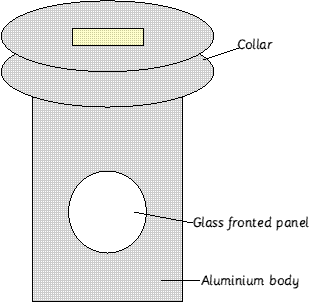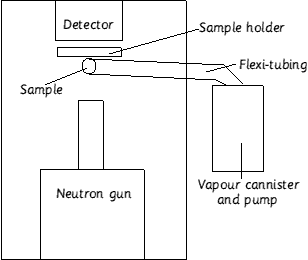NEUTRON SCATTERING
Experiment 1 - Determination of contrast match.
A series of solutions containing distilled water and D2O were made up (W/V). A small mount of solution was placed into a plastic dish into which the opal was placed. This was then left for 10 minutes to allow for the opal to take up the solution.
After 10 minutes, the sample was taken out of the solution and wrapped in a protective aluminium foil shield (this was more to keep the opal in one place, aluminium is invisible to the neutron beam). This was then sealed, removed from the preparation area and placed infront of the beam in LOQ and run.
At the end of the run, the sample was removed from the aluminium foil holder and placed in an heater cupboard for half an hour. It was then removed and placed into the next tray containing the next solution.
This process was repeated for all the solutions.
Care was taken not to touch the opal with bare hands - this would introduce grease onto the opal surface and affect the uptake of liquid.
Experiment 2 - Effect of infill on contrast match.
Two samples of opal were previously treated with diethylenglycol-dimethacrylate
and styro.. These were treated in the same way as described in experiment 1. The
infill was effectively 100% in each.
Experiment 3 - effect of vapour pressure on scattering
Diagram 16 shows the sample holder used in this experiment and diagram 17, a
simple schematic of the set up used as a whole.

Diagram 16. Special cannister used in experiment 3

Diagram 17. Simple schematic of experimental set up
After the correct contrast match had been attained (water / D2O), a litre was made up and left to reach thermal equilibrium.
While this was happening, the sample holder was connected to the flexi-tubing which in turn was connected to the vacuum pump. This was switched on an allowed to pressure down for 30 minutes. When the pressure was at zero, the pump was switched off and the pressure rise noted. This was repeated a number of times to ensure that there was a good seal between the sample holder, pipe and pump (and to also ensure the pipe was not damaged).
Once satisfied, a blank run was recorded for the sample holder.
The pump had two cannisters, an empty (for trapping vapours on return and the liquid cannister. The liquid cannister was filled with the contrast match solution and returned to the pump. The sample was encased in a sheet of aluminium foil and placed into the cell holder so the opal was in the glass (it was made simpler to observe by gently depressing around the edges of the sample, taking care not to damage either the opal or the foil), it was kept in place with insulating tape at the top of the cannister. The flexi-tube was then replaced and pumped down again to zero pressure.
Again, this was left to settle at zero using the method outlined above.
Vapour was introduced into the line by opening the liquid cannister to the system. This was at a controlled pressure. After the pressure had been attained, the liquid cannister was turned off and the system left for 10 minutes. The sample was then exposed to the neutron beam.
After exposure, the vacuum was applied to remove liquid from the line and from the sample. This was left for 30 minutes.
The above was then repeated for successive pressures upto a
![]() .
.
HYSTERISIS EXPERIMENTS
Experiments 1 and 2 were performed at Hiden Laboratories by Mike Tucker under experimental instruction from myself, Dr T.L. Crowley and Miss A Moran. Experiments 3 and 4 were performed at University of Salford by Jose under experimental instruction from myself.
Experiment 1 - short time hysterisis
A sample of opal of known weight was placed into the microbalance and
depressurised to a pressure of 1 x 10-6 mbar. The system was then
heated to 350°C to ensure the sample was totally dry.
The sample was then exposed to a gradually differing partial pressure of water over a 10 hour period. This was then depressurised to obtain the negative loop.
Experiment 2 - long period hysterisis
A second sample was treated in the same way as the first (depressurising and
heating) and left over a weekend with the pressure changes being far more
gradual. The reverse was also performed.
Experiment 3 - determination of percentage infill (rough).
A known weight sample was placed into the balance and allowed to reach a thermal
equilibrium. The sample containment chamber was then evacuated and left for a
while to ensure for no leaks.
When satisfied, the sample was exposed to a fast but controlled amount of vapour and the weight difference taken. At the end of the forward experiment, the reverse experiment (removal of vapour) was performed.
Experiment 4 - determination of percentage infill
The same sample as was used in experiment 3 had been dried overnight in a heater
cupboard. The same procedure was used with the difference being the introduction
of vapour being very gradual with the same speed taken on the reverse loop.